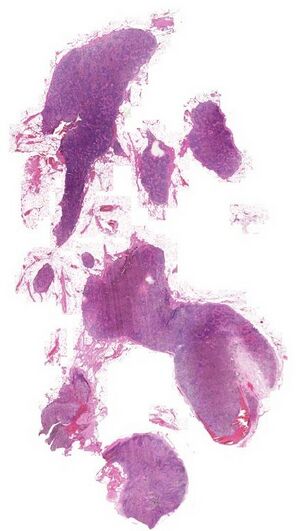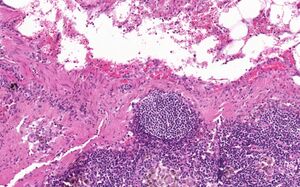11. Anthracosis of lymph node: Difference between revisions
(Created page with "'''Staining''': HE '''Organ''': Lymph node '''Description''': Secondary lymphoid follicles can be seen, indicating that this is a lymph node. Blackish pigment can be seen in parts of the slide. '''Diagnosis''': Anthracosis of lymph node '''Causes''': * Living in urban surroundings * Coal worker’s pneumoconiosis '''Theory''': Anthracosis is an asymptomatic disease that can be seen in to some extent in anyone who lives in urban surroundings, due to air pollution....") |
(No difference)
|
Revision as of 08:57, 9 May 2022
Staining: HE
Organ: Lymph node
Description:
Secondary lymphoid follicles can be seen, indicating that this is a lymph node. Blackish pigment can be seen in parts of the slide.
Diagnosis: Anthracosis of lymph node
Causes:
- Living in urban surroundings
- Coal worker’s pneumoconiosis
Theory:
Anthracosis is an asymptomatic disease that can be seen in to some extent in anyone who lives in urban surroundings, due to air pollution. It manifests as blackish lymph nodes and blackish dots on the pleural surface of the lung parenchyme. It’s caused by dust, an exogenous pigment.
Another disease called silicosis is related to this topic. It is caused by inhalation of dust composed of silica, a very fine dust that coughing cannot get rid of when it gets into the alveoli. Macrophages enter the picture and cause inflammation that ends in fibrosis.
Coal worker’s pneumoconiosis (CWP) is an occupational disease that is often seen in (you guessed it!) coal workers and other workers that work with coal. CWP is characterized by both anthracosis and silicosis.
What’s important to know about this slide is that the pigment is only found inside macrophages in the lymph nodes and not anywhere else. These macrophages are in the sinus-spaces in the lymph nodes.



